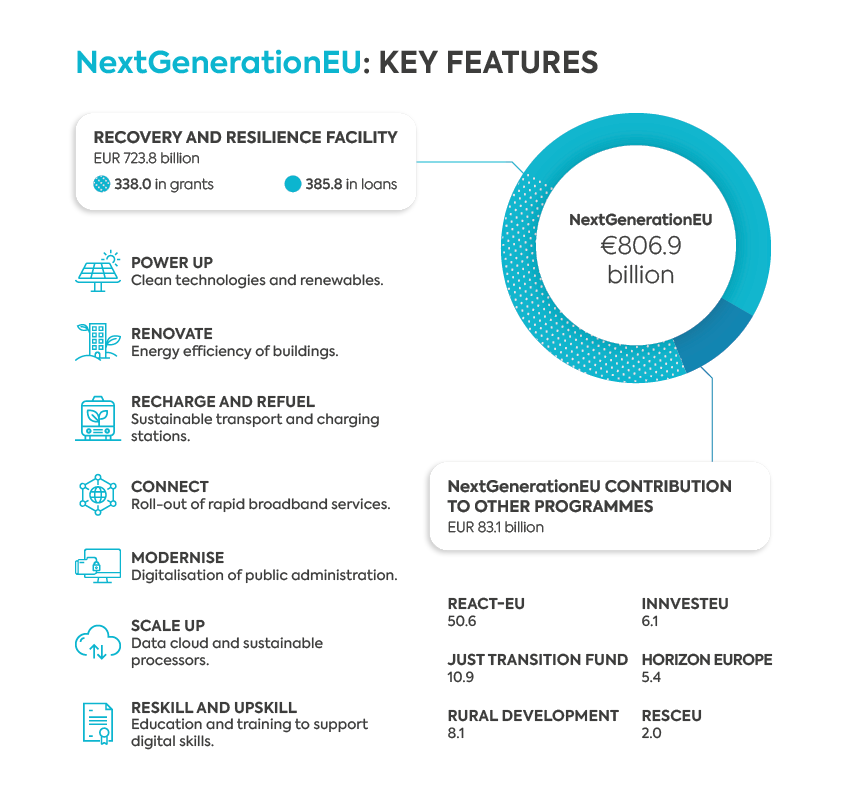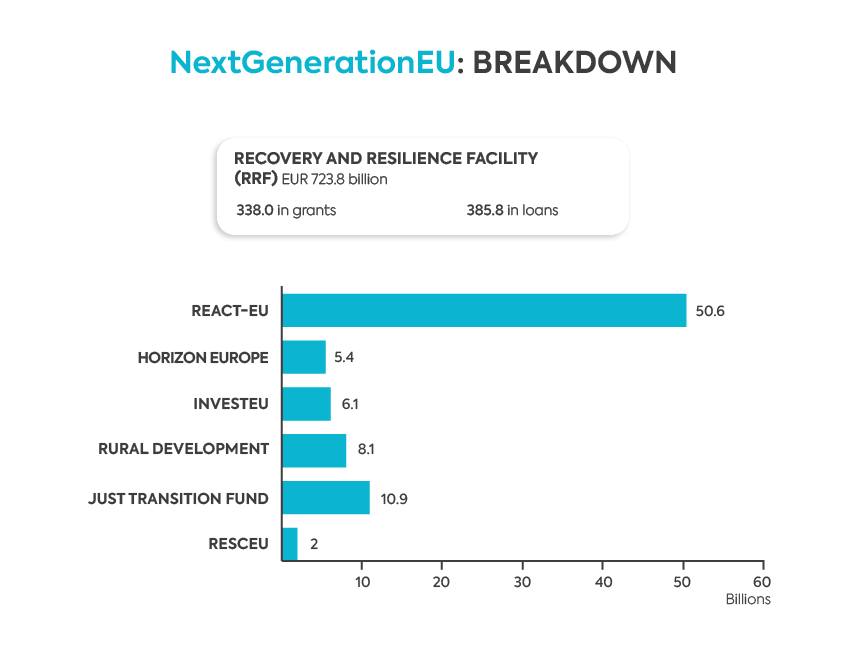Next Generation EU: Key Facts about the European Recovery Plan

Next Generation EU is the name given to the economic Recovery Plan launched by the European Union (EU) to counteract the economic and social damage brought on by the coronavirus pandemic on countries belonging to the eurozone.
An ambitious plan worth €806.9 billion that will be distributed among different programs and aid lines, designed with three very specific objectives: to promote the digital transformation of Europe, to promote the resilience of the countries that are part of the Eurogroup and opt for more environmentally sustainable economic development models.
Therefore, keeping abreast of the latest news on the European Recovery Plan is essential for your company to emerge stronger after the COVID-19 crisis.
In order to prepare for this new, more digital, greener and more resilient European horizon, in this article we share the main points to understand the Next Generation EU program. Don’t miss out!
What is Next Generation EU?
Next Generation EU is the Recovery Plan launched by the EU with the purpose of helping to repair the economic and social damage caused by the coronavirus pandemic. A package of aid that aims to serve as an economic stimulus, together with the budget of €1,211 billion approved by the EU for 2021-2027.
Specifically, Spain will receive €140,000 million, of the total €806.9 billion to which Next Generation EU amounts. An economic stimulus with which it is intended to pave the way of recover for all the countries that are part of the EU and contribute to the construction of a more modern and sustainable Europe.
The financing of the Next Generation EU aid plan is managed by the European Commission, which is the body authorized by the EU Treaty to borrow on the markets on behalf of the countries that make up the Eurogroup. Based on this precept, the system that the European Commission will follow to finance Next Generation EU will consist of the issuance of bonds and a diversified funding strategy, between 2021 and 2026, in order to raise the Recovery Plan’s funding of around €800 billion.
Next Generation EU is considered the largest economic stimulus package ever financed in Europe. A temporary recovery instrument whose total amount has quantifiable objectives to support modernization (50%), the fight against climate change (30%) and, finally, digitization (20%).
Main investment channels for Next Generation EU funds
A large part of the Next Generation EU funds (723,800 million euros) will be allocated to the program called the Recovery and Resilience Facility (RRF) that came into force on February 21, 2021 and whose validity will last until December 31, 2026. This program will provide financial funding for Eurogroup Member States to undertake reforms and investments related to:
1. Green projects
At least 37% of allocated funding.
2. Projects for digital transition
At least 20% of the investment.
3. Projects for the creation of emblematic European areas
Their purpose is to promote employment and boost the growth of the economy, through different lines of investment and reforms in the following areas:
-
Power up: Promote the use of clean and renewable technologies.
-
Renovate: Construction of energy efficient buildings.
-
Recharge and refuel: Sustainable transport and increase in recharging points
-
Connect: Deployment of fast broadband services.
-
Modernise: Modernization of Public Administration.
-
Scale up: Promote Data Cloud services.
-
Reskill and Upskill: Education and training to support digital skills.

Funding for all these projects, included within the RRF program, will be in the form of grants (€338 million) and loans (€385.8 billion), with the aim of better preparing Member States for a stable and sustainable recovery.
All those Member States that wish to apply for financial aid within the framework of the RRF program must draw up a recovery and resilience plan and present it to the European Commission. Said body will evaluate each of the plans, within a period not exceeding two months from the date of receipt. The result of this evaluation will be reflected in a proposal that the European Commission will submit to the approval of the European Council, within a maximum period of four weeks, as a general rule.
On the one hand, Member States whose recovery and resilience plans have received the approval of the European Council, will be able to benefit from a pre-financing of 13%.
On the other hand, the European Council reserves the right to reject all those plans that fail to meet the financing objectives of the RRF program, (green projects (37% investment), digital projects (20%) and ’emblematic areas’) preventing the Member State from receiving any type of aid related to the RRF program.
Other Next Generation funded projects
In addition to the RRF program, the Next Generation EU funds will contribute to the promotion of other programs, such as:

1. Recovery Assistance for Cohesion and the Territories of Europe (REACT-EU)
This program will amount to €50.6 billion, with which it is intended to expand and strengthen the response to the crisis derived from COVID-19, through two instruments: the Investment Initiative in Response to Coronavirus and the Investment Initiative in Response to Coronavirus Plus.
2. Just Transition Fund (JTF)
The Just Transition Fund (JTF) has a global budget of €17,500 million for the period 2021-2027, of which €10,900 million come from Next Generation EU.
The objective of the JTF is to support all the countries in the eurozone that need to start a process of reconversion of their production model towards a more sustainable model.
3. Rural Development
The European Rural Development Fund (EAFRD) represents one of the main means of financing, together with the national budgets of each country, of projects framed within the Common Agricultural Policy (CAP).
However, the pandemic has highlighted the need to support economic activity in rural areas even more, and therefore, it has been agreed to extend the EAFRD 2021-2027 budget, with 8,100 million from Next Generation EU.
All of this will allow each Member State to launch Rural Development Programs (RDPs), both at national and regional level, which will be supervised by the European Commission
In addition, each PDR must meet at least four of the requirements indicated below:
-
Encourage the transfer of knowledge and innovation in the agricultural, forestry and rural areas.
-
Increase the viability and competitiveness of all types of agriculture, together with the use of innovative technologies and the sustainable management of forests.
-
Promote the organization of the food chain, animal welfare and risk management in agriculture.
-
Promote resource efficiency and support the move to a low-carbon economy. – Restore, conserve and improve ecosystems related to agriculture and forestry.
-
Increase social inclusion, poverty reduction and economic development in rural areas.
4. InvestEU
The InvestEU program seeks to attract public and private investment, which will support companies and policies implemented in the EU, for the economic recovery of all Member States. For this, more than €372,000 million will be mobilized, through an EU budget guarantee of €26,200 million, which is backed by various financial institutions, such as the European Investment Bank (EIB).
The main lines of financing for this program, paid for with part of the Next Generation EU funds (€6,100 million) are: construction of sustainable infrastructures, promotion of research, innovation and digitization, financial support for SMEs and, finally, social investment.
5. Horizon Europe
Horizon Europe is an EU funding program that seeks to promote research and innovation in the Member States. The program has a total funding of €95,500 million, of which €5,400 million come from Next Generation EU funds.
Purposes set by Horizon Europe include: meeting the Sustainable Development Goals (SDGs) set by the UN in the 2030 agenda, and boosting the growth and competitiveness of the EU.
6. RescEU
Lastly, the RescEU program seeks to strengthen the capacity of action of the countries that are part of the Eurogroup, in the face of natural disasters of various kinds, such as forest fires, earthquakes and epidemics.
The contribution of Next Generation EU funds to this program is up to €2,000 million and will allow the creation of a reserve of civil protection response teams to tackle national catastrophes which overwhelm the Member States.



